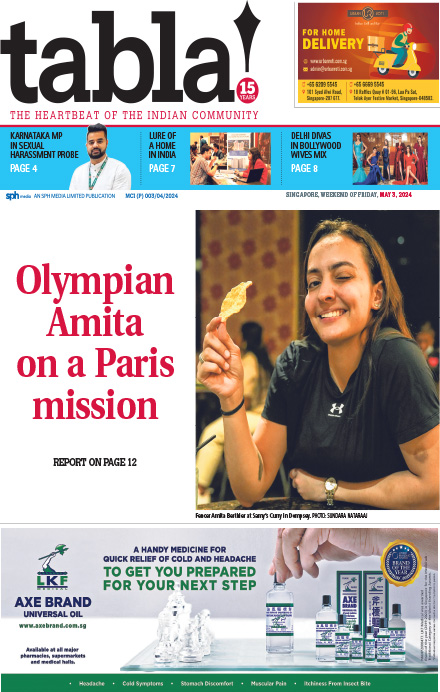The Indian Heritage Centre’s new exhibition was launched by Deputy Prime Minister Heng Swee Keat last Friday, and will run till June 30. Called From The Coromandel Coast To The Straits: Revisiting Our Tamil Heritage, it features more than 230 artefacts that showcase the diversity and long history of Tamils in Singapore and the region. Here are six highlights.
Holographic Singapore Stone fragments (11th to 13th century, Singapore)
Just one fragment remains from this large 3m-by-3m sandstone boulder that once stood at the mouth of the Singapore River before it was blown up by the British in 1843. One mystery is the 50 lines of Kawi - a South-east Asian script derived from Brahmi - carved into the stone's surface. Recently, Dr Iain Sinclair, a former visiting fellow at the ISEAS - Yusof Ishak Institute, identified a phrase, "kesariva", which could be from Parakesarivarman, a title used by several Chola kings. The finding suggests Tamil presence in the Straits of Singapore as far back as a thousand years. And while one fragment of the stone is in the National Museum of Singapore's collection, two others were recorded in an 1848 Journal of the Asiatic Society of Bengal article. They were said to be with the Indian Museum, but the Indian Heritage Centre (IHC) and the museum debunked this rumour last year. The two fragments' whereabouts are now unknown. But holographic 3D models of the fragments have been recreated using rubbings of the stone from the 1848 article. In a first for the IHC, it worked with a Singapore-based vendor to create interactive models that can be rotated 360 degrees virtually, by touch.
Tamil Bell (17th to 18th century, made in Tamil Nadu, discovered in New Zealand)
A Christian missionary in New Zealand came across a curious sight in 1841. Maori near Whangarei, in the country's Northland region, were using what looked like part of a bell to boil potatoes. They said their ancestors had found it in the roots of a tree that had fallen in a storm. More curious was the fact that the bronze object carried an inscription running around it in Tamil: "Mohideen Bux udiya kappal udiya mani", meaning the bell belonging to Mohideen Bux's ship. Mohideen Bux was a common name for ships owned by Muslim maritime communities operating out of ports along the Coromandel Coast, the colonial name for the south-eastern coast of the Indian subcontinent. Such trade between Ceylon (Sri Lanka) and South-east Asia declined by the 19th century. The missionary, William Colenso, bequeathed it to the Dominion Museum, today the Museum of New Zealand Te Papa Tongarewa, from which the Indian Heritage Centre has loaned the artefact.
Masala by Kumari Nahappan (Bronze, 2019)
Well known for her iconic public sculptures based on seeds and spices scattered around Singapore, Singaporean artist Kumari Nahappan has cast her very own spice blend in bronze to welcome visitors to the Indian Heritage Centre. The triplet of chilli, clove and nutmeg is aptly titled Masala, referring to the unique mixes of different spices ubiquitous to Tamil cuisine. The installation, meant to celebrate the historical importance of the spice trade between the Tamil coast and South-east Asia, also features fresh patches of green herbs in contrast to their bronze counterparts depicting the dried version of the spices.
Heart In Hand, A Marriage of Identities by Anurendra Jegadeva (Hand-painted wood, 2019)
One of three artworks commissioned by the Indian Heritage Centre for this exhibition in conjunction with the Singapore Biennale, this installation by Malaysian artist Anurendra Jegadeva is inspired by the shape of a thali, or Hindu wedding necklace worn by the bride. Against the male-dominated history of Tamil migrants, the artist has chosen his own daughter as the central figure surrounded by contradictory modern and traditional elements. The girl's Western-oriented values are contrasted with an inherited Tamil culture, conveying the disconnect, or even indifference, felt by the children of migrants as they negotiate issues of identity and place themselves.
Siva Nataraja (12th century, Tamil Nadu)
Walking into the exhibition, one of the first objects that greets visitors may be familiar yet still striking - the image of Nataraja, the iconic dancing form of the Hindu deity Siva. Nataraja combines the god's roles as creator, preserver and destroyer of the universe and symbolises the Indian concept of time's never-ending cycle. The four-armed bronze figure holds a hand drum and fire, and assumes the gesture of abhaya, or protection. His hair flies to the sides from the energy of his cosmic dance (ananda tandava). Each Nataraja bronze is unique as the creation processes require the mould to be broken. This one comes on loan from the National Museum in New Delhi. Appearing as early as the 5th century, production picked up during the Chola period as the figures were used for worship and as emblems of the Chola rulers. The art remains a living tradition.
Petition by Naraina Pillai (October 1822, Singapore)
Tamil community pioneer Naraina Pillai is well known for arriving in Singapore with Stamford Raffles in 1819. He established one of the island's first brick companies and quickly branched out into other lucrative trades, such as cotton. Unfortunately, his cotton store went up in flames in a fire in 1822. The merchant also built Singapore's oldest Hindu temple, the Sri Mariamman Temple, in 1827. A natural question for such a luminary is: What did he look like? No one really knows, as there is no known historical image of him. One account says he was "short and fat, and had a round face, which was usually beaming with pleasure, while his white teeth showed in a cheerful smile". But the IHC exhibition has something else: the man's signature, in Tamil and English, on two petitions addressed to Raffles for permission to erect a shop at the site where his business burned down.





